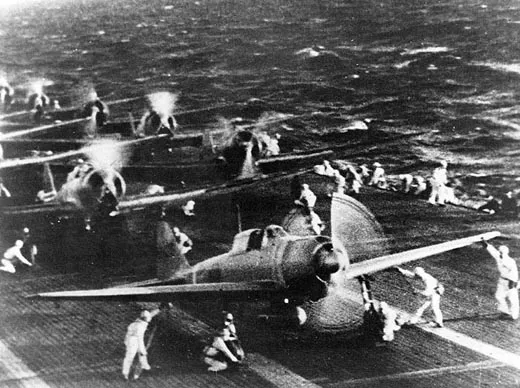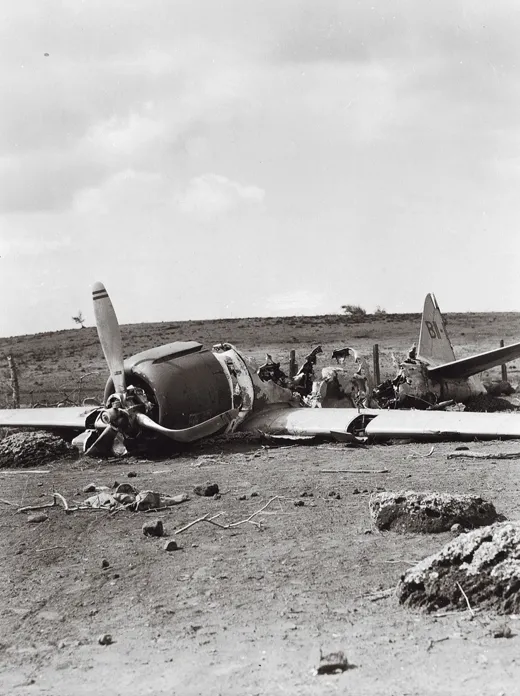Pieces of a Surviving Zero Tell a Different Pearl Harbor Story
A violent clash of cultures and a race for technology.
/https://tf-cmsv2-smithsonianmag-media.s3.amazonaws.com/filer/f0/bf/f0bfdaf6-f2c8-4127-a59b-13a8cedf75f9/niihau_zero.jpg)
Flying in the second wave of the attack, he had vanquished the remaining aircraft intended to protect Pearl, a task so easy that his own return flight to the carrier should have proved uneventful. But now his Zero was leaking fuel badly, forcing him to make an emergency landing. The barren island below, called Niihau, was tiny and of no consequence compared with the world-changing events that had unfolded earlier that morning, December 7, 1941. Yet six days later, Airman First Class Shigenori Nishikaichi would be dead, killed by an islander, while another island resident who had helped the pilot would take his own life, all the result of a strange incident of invasion and resistance in the Pacific war.
“I never knew about this,” visitors invariably tell education director Kathryn “KT” Budde-Jones as she guides them through the pieces of the ill-fated Zero on display at Ford Island’s Pacific Aviation Museum—Pearl Harbor (see Kauai; that he terrorized its native inhabitants, threatening to kill them all; that his aircraft survives, though burned and in pieces, preserving the story of Mitsubishi A6M2 type 0, model 21, tail number B11-120.
Even KT and her husband, Syd Jones, the museum’s director of restoration, did not know the tale. Both have had their share of adventure, from diving for Spanish galleons with treasure hunter Mel Fisher to piloting vintage aircraft at the Flying Tigers Warbird Museum in Florida, and both agree that the “Niihau Incident” is “befitting a Hollywood movie,” says KT, relating how the wayward Zero tumbled to Earth, knocking its pilot unconscious. And how ranch hand Howell Kaleohano rushed outside to find a smoking aircraft in his front yard.
“He and his fellow islanders had no inkling Pearl Harbor was under siege,” KT says (there were no telephones or electricity on Niihau). Nor could they understand the injured pilot (they spoke only Hawaiian). That night, as Pearl burned, the islanders treated their drop-in guest to a luau. Then the young Nishikaichi began demanding the return of his papers and weapons—items that the savvy Kaleohano had lifted on reaching the wreck.
“I played pilot in the wreck as a child, rata-tat-tat!” says Keith Robinson, who descends from the family of New Zealand farmers who bought Niihau from Hawaii’s King Kamehameha IV in 1864. Robinson’s uncle, Alymer Robinson, oversaw Niihau when the Zero crashed. Today, Keith’s mission is to preserve the endangered species that inhabit the island, along with its Hawaiian language and culture.
In the museum’s exhibit, B11-120 lies in fragments, arranged to correspond to how this Rei Shiki Sentoki (Type 0 Fighter) came to rest amid the boulders and abutilon weeds of Niihau just hours into the Pacific war. Syd Jones had heard stories about a crashed Zero on Niihau, but the trail went cold after U.S. inspection teams had disassembled it in 1941. He found a historian, Allan Lloyd, who reported that he had been to Niihau, had met the Robinsons, and had seen the wreckage. After grilling the Joneses on their motives, Lloyd put the pair in touch with Keith Robinson, who ultimately wanted only to get the real story of the Niihau Zero on the record.
“We treated it as an archeological site,” Syd recalls of his 2006 trips to secluded Niihau, once called “the Forbidden Isle” and even today accessible only with permission from the Robinson family. “I wrote up pre-disturbance guidelines for us to follow. Very little info comes out of Niihau, so we really didn’t even know where the aircraft was, relative to where it crashed, or what state it was in.”
Syd’s first challenge was reconstructing the crash itself. To do so, he flew Nishikaichi’s 1941 approach to the island, some 150 miles northwest of Pearl Harbor. “We wanted to see if there was some possible way of finding additional pieces of the wreck, [to] establish a primary scatter trail of artifacts as the aircraft bellied in,” he says. Eyewitness testimony honed the search. “We interviewed a Niihauan who, as a young man, saw the plane come in. It turned out the aircraft was not where it originally crashed.” Prior to recovery, the team went to Niihau, prepared a photo-mosaic of the wreck, and tagged the larger pieces for later identification.
Back to Oahu’s Ford Island, to reconstruct the airplane and what actually happened. “We laid out the parts in a grid on the museum floor,” Syd says, “to identify what part went where, in the proper relationship and spacing from each other. We were able to identify about 95 percent of the pieces we found. Fortunately, there was another A6M2 in our hangar we could refer to”—a Nakajima-built Zero recovered from the Solomon Islands, restored, and recently acquired from the Commemorative Air Force. “We had the drawings, but it’s easier to go to the real thing.”
The wing, portions of the tail, the elevator, and an aft section of its 950-horsepower Nakajima Sakae twin-row 14-cylinder engine survive. Zeros were light—about two-thirds the weight of a Supermarine Spitfire—though what remains seems sculpted from Reynolds Wrap. “Sitting outside in a salty environment for 60 years didn’t do this plane any favors,” Syd says. “Still, this is the largest surviving collection of artifacts from any [aircraft] shot down at Pearl.”
As displayed today, the fragments record B11-120’s three lives: invading aircraft, captured secret weapon, and forgotten wreck. It still has the mounting points for the two 20-mm cannon Nishikaichi used to lay waste to Hickam Field and Kaneohe Air Base. A piece of a drop tank remains—the pilot didn’t jettison it before crashing. Was B11-120 out of fuel? Eyewitnesses told Keith Robinson the airplane glided in, engine dead. “A[n early] Zero’s main tanks wouldn’t self-seal after being hit,” Syd notes. Perhaps something at Pearl—a ground gun?—found its mark.
There is burn damage across the main spar and beneath the cockpit, though not from the crash. “Japanese pilots had been ordered to emergency-ditch on Niihau to await a rescue sub,” Syd explains. “But the sub rescue never came off. So the pilot set his plane on fire to keep its secrets from the Allies.” Then, desperate to force the return of his papers, Nishikaichi began to terrorize the islanders.
Keith Robinson recalls the scene from Niihau lore—how the Kiawe trees shuddered as the pilot sprayed them with the Zero’s 7.7-mm machine guns; the islanders fleeing into the jungle, lighting bonfires and shining flashlights to signal the neighboring islands. Howell Kaleohano managed to reach a whale boat. He rowed for 10 hours to Kauai, where Alymer Robinson—unable to reach Niihau because of an emergency Navy curfew—fretted over his island’s fate. Another islander, Bene Kanahele, fought the Japanese pilot. In the last moments of the siege, he took three slugs from the pilot’s pistol but kept coming, finally throwing Nishikaichi against a stone wall. Kanahele’s wife, Ella, bashed the pilot’s head with a rock, and Kanahele slashed his throat, killing him.
The frenzy of the Allied inspectors who rushed in days later to examine one of the “superplanes” that had just vanquished the U.S. Pacific fleet is apparent in the torn-up wreck. “My Uncle Alymer brought them over in sampans to find out what made this plane tick,” Robinson recalls.
“The inspectors actually used hacksaws and axes,” Syd says. He’s found the tooling marks. “Anything removable came off. The landing gear is gone. They took almost every wire. All the hydraulic stuff.” Why such haste? “There was fear of a second attack, and invasion, at any moment,” Robinson says.
Fortunately, the Niihauans proved more careful curators. Gilbert K. Pahulehua Jr. is now chief elder on the island. “He saw us coming,” Syd recalls, describing how Pahulehua emerged from his house carrying a piece of the Zero’s engine that his father had preserved. Photographs survive thanks to another unlikely source—the Reverend Paul Denise, a clergyman on Kauai, who joined the mission to examine the wreck. As inspectors hacked up the airplane, the Presbyterian minister quietly snapped over 500 photos, compiling the Allies’ first reliable dossier on Japan’s most secret aircraft. “Of course the Navy took possession of those photos,” recounts Craig Barnum, Denise’s grandson.
“As soon as the inspection was finished,” Syd says, “what was left was dragged about 300 yards [to] beneath a stand of trees, to conceal from Japanese reconnaissance that a plane had landed on the island and was captured.” There B11-120’s hulk remained, obscured but not entirely idle in the hands of the resourceful islanders. “They peeled off swatches of the aluminum wing skin,” Robinson says. “Perfect for rolling into eyelets for their fishing nets.” The Robinson family eventually agreed to loan the wreck to the museum.
For his valor, Howell Kaleohano was awarded a Medal of Freedom in 1946. Bene Kanahele received a Medal of Merit and a Purple Heart. Against stunning defeat at Pearl Harbor, their unlikely victory received national acclaim. The December 1942 issue of Reader’s Digest regaled its audience with the exploits of the “full-blooded descendants of ancient Hawaiian warriors.” A wry Hawaiian ditty entitled “They Couldn’t Take Niihau, No-How,” penned by musician Alex Anderson, became America’s first World War II victory song.
One mystery remains unsolved: the tragedy surrounding Yoshio Harada. A Nisei (second-generation Japanese-American) living on the island, he spoke with the pilot, but did not reveal the attack on Pearl to the others. He then helped Nishikaichi terrorize the villagers before shooting himself when the siege ended. Whatever motivated Harada’s alliance, others would pay dearly for it. “The incident was used to help justify the dislocation and internment of thousands of Japanese-Americans during the war,” says KT Budde-Jones. “So many worlds collided when this plane crashed here.”

